English summary: In 1990, the fragment of a panel dating back to the
13th century was found in the choir stalls of the cathedral of Trogir.
Technological aspects of this work of art have been examined and the
importance of the panel has been discussed against the background of its
creation in the Dalmatian seaside town which was then under the
influence of Byzantium and the West. Studies on the history of the city
of Trogir, on its cathedral and on its local adoration of saints are the
basis for these studies.The panel is special because it has been spared
from later treatment, thanks to the fact that it has been built into the
choir stalls. Therefore it was possible to study the medieval painting
technique in a unique way. Comparisons with artwork from the western
sphere illustrate the isolated status of the panel. Its sumptuous and
ingenious painting technique is bound to originate from the Byzantine
East. Studies regarding the reconstruction and proportion of the
original design, form and size of the panel have been made and they
delivered important basic information both regarding the typological
classification and function and the original installation site of the
panel at the cathedral of Trogir. German description: Das Tafelbild von
Trogir, als Hochaltarretabel fur die Kathedrale des kleinen
dalmatinischen Stadtchens an der ostlichen Adriakuste geschaffen, stellt
ein einzigartiges kulturelles und kunstlerisches Zeugnis der fruchtbaren
Begegnung von Osten und Westen dar. Das Tafelbild entspricht formal der
westlichen Kunstgattung, folgt aber in Planung und Ausfuhrung ostlichen
Konventionen und spiegelt somit die lebendige Spannung zwischen der
ostlichen hoch-byzantinischen und der neu entstehenden westlichen
Tafelmalerei wider.Der erste Teil der Arbeit beschaftigt sich mit der
Geschichte Dalmatiens und der Stadt Trogir, die politisch und kulturell
im Spannungsfeld zwischen Byzanz und Rom, zwischen dem ungarischen
Konigreich und Venedig lag. Daran schliessen sich Studien zur Kult- und
Liturgiegeschichte der Stadt Trogir an, die trotz der geographischen
Nahe zur Ostkirche an die romische Kirche gebunden war. Neben den Fragen
aus dem Kontext des Fundortes bilden Untersuchungen am Tafelbild selbst
den Kern der Arbeit. Nach einer Beschreibung der Darstellung werden
Holztechnik, vorbereitende Massnahmen fur die Malerei und die
Maltechniken bis ins Detail untersucht und erfasst. Daruberhinaus
bezieht Cristiana Thieme stilistische und qualitative Eigenschaften der
Malerei ein. Schliesslich wertet sie die umfangreiche kroatische
Literatur aus, um das Tafelbild von Trogir mit der dalmatinischen
Tafelmalerei des 13. Jahrhunderts vergleichen zu konnen.

